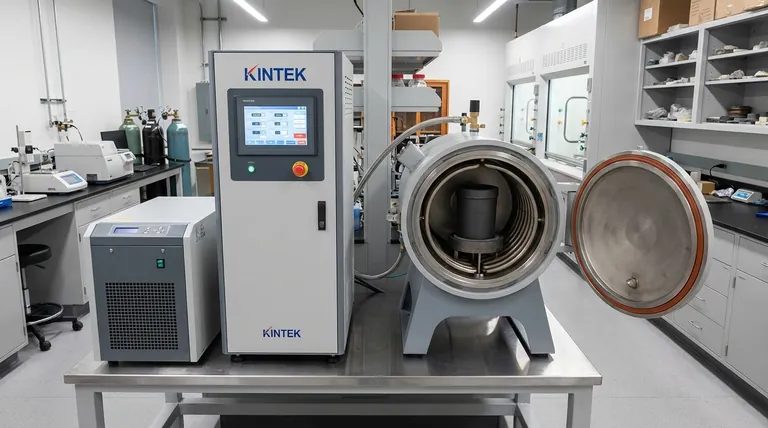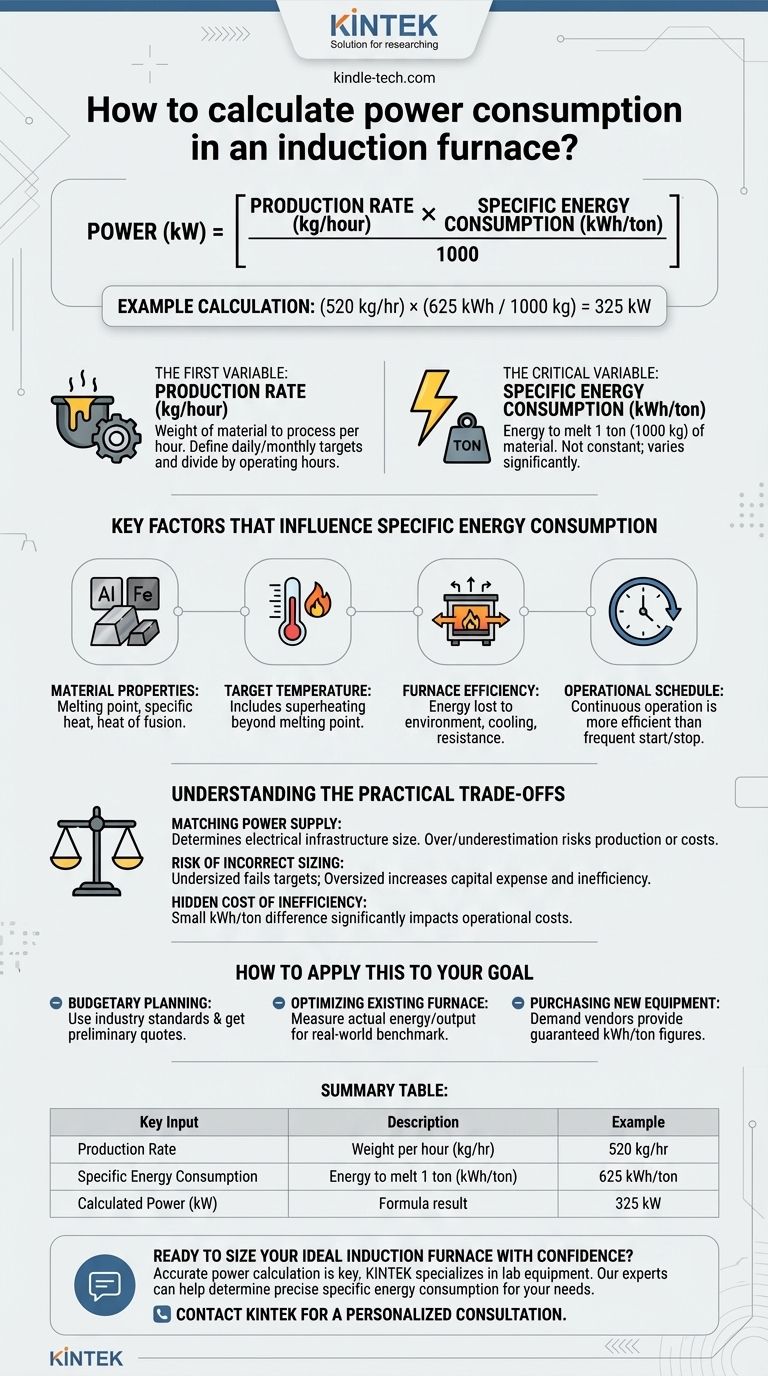To calculate the power consumption of an induction furnace, you must multiply your required hourly production rate by the specific energy consumption value for the material you are melting. For example, if you need to produce 520 kg of steel per hour and the specific energy consumption for that process is 625 kWh per ton, the required power is calculated as (520 kg/hr) × (625 kWh / 1000 kg), which equals 325 kW.
The core of an accurate power calculation is not the formula itself, but determining the correct specific energy consumption (kWh/ton) for your unique application. This single value is influenced by the material, target temperature, and furnace efficiency.

Deconstructing the Power Calculation
Understanding the two primary components of the formula is essential for an accurate estimation. The calculation is straightforward, but its accuracy depends entirely on the quality of your input values.
The First Variable: Production Rate (kg/hour)
This is the most direct factor in the calculation. It is simply the weight of the material you need to process within a one-hour timeframe.
To determine this, you must define your operational needs. Consider your daily or monthly production targets and divide them by the number of available operating hours.
The Critical Variable: Specific Energy Consumption (kWh/ton)
This value represents the amount of electrical energy required to melt one ton (or 1000 kg) of a specific material and bring it to the required temperature.
This is not a universal constant. It changes significantly based on several factors and is the most common point of error in estimations. This value is typically provided by the furnace manufacturer or found in engineering handbooks for specific metals.
The Complete Formula
With both variables, the formula is simple:
Power (kW) = [Production Rate (kg/hour) × Specific Energy Consumption (kWh/ton)] / 1000
The division by 1000 is necessary to align the units, converting the production rate from kilograms to tons to match the specific energy consumption value.
Key Factors That Influence Power Needs
The specific energy consumption value is not arbitrary. It is a reflection of the physics of the melting process and the efficiency of your equipment. Understanding these underlying factors is crucial for both planning and optimization.
Material Properties
Different materials require vastly different amounts of energy. Factors like the material's melting point, specific heat, and heat of fusion dictate the energy needed. For example, melting aluminum requires significantly less energy per ton than melting iron.
Target Temperature
Simply reaching the melting point is often not enough. Most processes require superheating the molten metal to a higher casting temperature, which demands additional energy input and increases the kWh/ton value.
Furnace Efficiency
No system is 100% efficient. Energy is always lost to the environment through the furnace lining, cooling water, and electrical resistance in the power supply. An older, poorly maintained furnace will have higher heat losses and therefore a higher actual energy consumption per ton compared to a modern, well-insulated unit.
Operational Schedule
Continuous operation is typically more energy-efficient. A furnace that runs 24/7 avoids the significant energy waste associated with repeated heat-up cycles from a cold start. Starting and stopping the furnace frequently will increase your average power consumption.
Understanding the Practical Trade-offs
Calculating the required power is not just an academic exercise. It has direct consequences for capital investment, operational costs, and infrastructure planning.
Matching Power Supply to Demand
The calculated power in kW determines the required size of your electrical infrastructure. You must ensure your facility's power service can handle this load. Underestimating this can lead to an inability to meet production targets, while significant overestimation results in unnecessary infrastructure costs.
The Risk of Incorrect Sizing
Choosing a furnace based on an inaccurate power calculation is a costly mistake. An undersized furnace will fail to meet your production rate. An oversized furnace represents a higher capital expense and may operate inefficiently when not running at its full, intended capacity.
The Hidden Cost of Inefficiency
A small difference in the specific energy consumption (kWh/ton) can translate to substantial operational costs over the life of the furnace. An inefficient process or poorly chosen equipment directly increases your electricity bill, impacting profitability month after month.
How to Apply This to Your Goal
Your approach to this calculation should depend on your specific objective.
- If your primary focus is budgetary planning: Use industry-standard specific energy consumption values for your material and get preliminary quotes from furnace manufacturers to establish a baseline.
- If your primary focus is optimizing an existing furnace: Measure your actual energy usage (kWh) and output (tons) over a set period to calculate your real-world specific energy consumption. This becomes your benchmark for improvement efforts.
- If your primary focus is purchasing new equipment: Demand that vendors provide a guaranteed specific energy consumption figure (kWh/ton) for your precise material and temperature requirements.
Ultimately, mastering this calculation empowers you to make sound financial and operational decisions for your melting process.
Summary Table:
| Key Input | Description | Example |
|---|---|---|
| Production Rate | Weight of material processed per hour (kg/hr) | 520 kg/hr |
| Specific Energy Consumption | Energy needed to melt 1 ton of material (kWh/ton) | 625 kWh/ton |
| Calculated Power (kW) | (Prod. Rate × Spec. Energy) / 1000 |
325 kW |
Ready to size your ideal induction furnace with confidence?
Accurate power calculation is the first step to an efficient and cost-effective melting operation. An incorrect estimate can lead to production bottlenecks or wasted capital on oversized equipment.
KINTEK specializes in lab equipment and consumables, serving laboratory needs. Our experts can help you determine the precise specific energy consumption for your material and production goals, ensuring you invest in a furnace that meets your exact requirements. Don't leave your project's success to chance—get a professional assessment today.
Contact KINTEK for a personalized consultation to optimize your melting process and control your energy costs.
Visual Guide

Related Products
- Lab-Scale Vacuum Induction Melting Furnace
- Vacuum Heat Treat Furnace and Levitation Induction Melting Furnace
- 600T Vacuum Induction Hot Press Furnace for Heat Treat and Sintering
- 1400℃ Laboratory Quartz Tube Furnace with Alumina Tube Tubular Furnace
- Vertical Laboratory Quartz Tube Furnace Tubular Furnace
People Also Ask
- What is the principle of vacuum induction melting? Achieve Ultra-High Purity Metals
- What are the advantages of induction melting? Achieve Faster, Cleaner, and More Controlled Metal Melting
- What is VIM in metallurgy? A Guide to Vacuum Induction Melting for High-Performance Alloys
- What is the vacuum induction method? Master High-Purity Metal Melting for Advanced Alloys
- What is the process of vacuum melting? Achieve Ultra-Pure Metals for Critical Applications



















